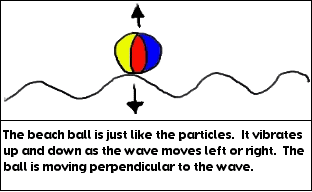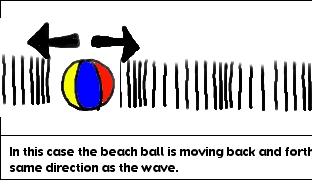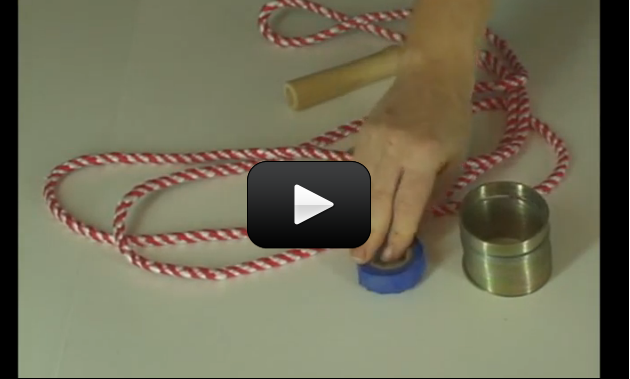Since we can’t see soundwaves as they move through the air, we’re going to simulate one with rope and a friend. This will let you see how a vibration can create a wave. You’ll need at least 10 feet of rope (if you have 25 or 50 feet it’s more fun), a piece of tape (colored if you have it), a slinky, and a partner. Are you ready?
[am4show have=’p8;p9;p16;p43;p64;p75;’ guest_error=’Guest error message’ user_error=’User error message’ ]
1. Give one end of the rope to your partner.
2. Stretch the rope out so that it is a bit slack.
3. Now move your hand up and down. Feel free to do it several times in a row. Your partner should keep his or her hands as still as possible.
4. Watch the waves move from your hand to the other end of the rope.
5. Now let your partner create waves.
6. If you wish, you can try to time your vibrations and create waves with specific frequencies. A frequency of one Hertz is fairly easy to do (one rope shake per second). Can you create rope waves of higher frequencies? You may find that your arm gets tired pretty quickly!
Your hand is the vibrating particle. As your hand vibrated up and down, you moved the particles of the rope up and down. As those particles of rope vibrated, they vibrated the particles next to them. As they vibrated, they vibrated the particles next to them and so on and so forth. So the wave moved from your hand across the room. Did your hands move across the room. Nope, but the wave you created with your vibrating hand did.
This is the way energy travels. Why is the rope wave energy? Because the particles moved a distance against a force. Work was done on the particles. In fact, when you shook the rope, your energy from your body moved across the room with the wave and was transferred (moved to) your partner. Your partner’s hands could feel the energy you put into the rope in the first place. The work you did on the rope was transferred by the rope wave and did work on your partners hand. You have moved energy across the room!
Now… let’s add another element to this experiment…
Transverse Waves
1. Put a piece of (colored if possible) tape in about the middle of the rope.
2. Tie your rope to something or let your friend hold on to one end of it.
3. Now pull the rope so that it is a bit slack but not quite touching the floor.
4. Vibrate your arm. Move your arm up and down once and watch what happens.
5. Now, vibrate your arm a bunch of times (not too fast) and see the results. Notice the action of the tape in the middle of the rope.
 What you’ve done is create a transverse wave. With a transverse wave, if the particle (in this case your hand) moves up and down, the wave will move to the left and/or right of the particle. The word perpendicular means that if one thing is up and down, the other thing is left and right. A transverse wave is a wave where the particle moves perpendicular to the medium. The medium is the material that’s in the wave. The medium in this case is the rope.
What you’ve done is create a transverse wave. With a transverse wave, if the particle (in this case your hand) moves up and down, the wave will move to the left and/or right of the particle. The word perpendicular means that if one thing is up and down, the other thing is left and right. A transverse wave is a wave where the particle moves perpendicular to the medium. The medium is the material that’s in the wave. The medium in this case is the rope.
For example, in a water wave, the medium is the water. Your hand moved up and down, but the wave created by your hand moved across the room, not up. The wave moved perpendicular to the motion of your hand. Did you take a look at the tape? The tape represents a particle in the wave. Notice that it too, was going up and down. It was not moving along the wave. In any wave the particles vibrate, they do not move along the wave.
Longitudinal Waves
Now that you’ve seen a transverse wave, let’s take a look at a longitudinal wave. Here’s what you do:
1. Put a piece of tape on one slinky wire in the middle or so of the slinky.
2. Let your friend hold on to one end of the slinky or anchor the slinky to a chair or table.
3. Now stretch the slinky out, but not too far.
4. Quickly push the slinky toward your friend, or the table, and then pull it back to its original position. Did you see the wave?
5. Now do it again, back and forth several times and watch where the slinky is bunched up and where it’s spread out.
6. Notice the tape. What is it doing?
 Here you made a longitudinal wave. A longitudinal wave is where the particle moves parallel to the medium. In other words, your hand vibrated in the same direction (parallel to the direction) the wave was moving in. Your vibrating hand created a wave that was moving in the same direction as the hand was moving in. Did you take a look at the tape? The tape was moving back and forth in the same direction the wave was going.
Here you made a longitudinal wave. A longitudinal wave is where the particle moves parallel to the medium. In other words, your hand vibrated in the same direction (parallel to the direction) the wave was moving in. Your vibrating hand created a wave that was moving in the same direction as the hand was moving in. Did you take a look at the tape? The tape was moving back and forth in the same direction the wave was going.
Do you see the difference between a transverse wave and a longitudinal wave? In a transverse waves the particles vibrate in a different direction (perpendicular) to the wave. In a longitudinal wave the particles vibrate in the same direction (parallel) to the wave.
What’s the Difference between Amplitude and Wavelength?
Here’s an easy way to get a feel for amplitude:
1. Put a piece of tape in about the middle of the rope.
2. Tie your rope to something or let your friend hold on to one end of it.
3. Now pull the rope so that it is a bit slack but not quite touching the floor.
4. Your friend should hold their hands as still as possible.
5. Vibrate your hand but only move it up and down about a foot or so. Have your partner pay attention to how that feels when the wave hits him or her.
6. Now, vibrate your hand but now move it up and down 2 or 3 feet. How does that feel to your partner?
7. Have your partner do the vibrating now and see what you feel.
You created two different amplitude waves. The first wave had a smaller amplitude than the second wave. What you and your partner should have felt was more energy the second time. The wave should have hit your hand with more energy when the wave had more amplitude.
Here’s a great way to visualize wavelength:
1. Tie your rope to something or let your friend hold on to it.
2. Now pull the rope so that it is a bit slack but not quite touching the floor.
3. Your friend should hold their hands as still as possible.
4. Now begin vibrating your hand fairly slowly. In this case, it works better if you move your hand in a circle.
5. Try to make a wavelength with the rope. In other words it will look like you’re playing jump rope.
6. Now try a one and a half wavelengths.
7. Can you get two or more wavelengths? You’ve really got to get your hand moving to get it.

In this image, the left wave is ONE wavelength, the middle is 1.5 wavelegnths, and the right is TWO wavelengths. See the difference?
Did you notice how the frequency of your hand determined the wavelength of the rope? The faster your hand, moved the more wavelengths you could get.
[/am4show]


In transverse wave, energy is strongest at the point where rope is farthest from the middle. But, keep in mind that point is in motion as the energy travels down the rope.
is there a point in the rope were the energy is the strongest and if there is how can u find it
What happens to sound waves after we hear them? Do they keep going? Why don’t people far away from where the sound started hear it when it finally reaches them?
A water wave is a typical transverse wave, because the water moves up and down, which means that the water moves transversely compared to the travel path of the wave itself. Also, electromagnetic waves (like light) are also transverse waves. It’s like taking a bedsheet and flicking it up and and down quickly to see a wave move across the surface.
What types of energy travel in transverse waves? longitudinal waves?
The medium is the stuff the waves is traveling through. A light wave travels through the medium of empty space when it goes from the sun to the earth, and then it changes into the medium of the atmosphere when it gets close to the earth, and then the medium switches to glass as it goes through your window, and then the medium switches back to the earth’s atmosphere inside your room.
The radio tower is a EMR (electromagnetic radiation) source.
You’re right – it does get confusing! Here’s the deal: sound waves are not the same thing as radio waves. Radio waves are electromagnetic radiation (covered in Unit 9), where the wave itself (or in some cases, particles) travels through space by alternating magnetic and electrical fields. Sound waves are totally different – they are like waves you see when you collapse a length of dominoes or play with a slinky or do the ‘wave’ at a sporting event. The individual dominoes don’t move much, but they move just enough to whack into their neighbor and this is what propagates the sound. Sound travels by molecules vibrating – you can read more about this here.
Also, is the medium the source of the wave? Like the radio tower, for instance?
Hi Aurora!
Okay, I’m a little bit confused with the waves and particles and stuff. You said that the particles don’t move across the room, or from the radio tower to your radio, but then you said that the particles have done work as your energy has moved across the room through the wave. If the particles don’t move, but the wave does, how can the particles have done work?
Laura
Good question! And yes, just because you have your radio turned down doesn’t mean that the antenna isn’t receiving. The antenna is always picking up waves – it may not be outputting the signal to the speaker, but it’s constantly being bombarded with waves.
Hi Aurora,
We are doing the unit on sound and I have a question for you. If the radio is on and you turn the volume all the way down so that you cannot hear anything, is the antenna still picking up the waves? My mom doesn’t know.
KJ3
Hi Susan,
Thanks for your feedback – I really appreciate it. It sounds like you’re having trouble finding what you need from the site. Since there’s a lot of content, it’s totally understandable that it can get confusing. I’ve tried to make it as easy as possible to find what you need quickly, but I am also constantly working to improve it to work better for you!
If you haven’t already, you might want to watch the video that shows how to move around on the site. You can find that video here.
As for finding the video that goes with each lesson, you want to watch the upper right corner menu, which will change depending on where you are on the site. For example, on the sound unit, you’ll find Lesson 1 and Lesson 2 listed on the upper right. By clicking on lesson 1, you’ll be taken to the part of the site that has the video for lesson 1. If you click on lesson 2, then the menu updates to reflect all the content for lesson 2.
You’ll notice that within each lesson are four clickable areas in the upper right menu: Video (which is the overview video), Reading (which is a download you can print out containing background information and science concepts), Experiments, and Exercises. Each lesson contains these four areas, which can be done in any order (however they are listed in the order that I recommend using them in).
The experiments are in the order that I teach them in – sometimes I need to engage the kids with an ooh-ahh experiment before starting in on the concepts, but don’t feel that you need to do them in the order they appear. This program needs to work for your kids and your family!
Although it’s not obvious, each line of the syllabus refers to a new lesson.
Aurora–
I really like your personality and your love of science, but in my opinion your website needs some work. For example, we are working on the Sound Unit.
The “order of operations” confuses me: like which video comes first and exactly where to find it. The syllabus works great, but I cannot find a lecture (or video) labeled specifically for Lesson1, Lesson 2, etc. Also, for example, the experiment for Ear Antennaes comes before the experiment on Transverse and Longitudinal Waves.
Perhaps it was intended that way, but the lessons/videos occur to me as scattered, leaving me, a “non-scientist”, confused.
We are enrolled in Summer E-Camp through the end of the month. After that I’m not sure yet if we will continue. My 7th grader is extremely talented in the sciences so I need to be able to help him excel.